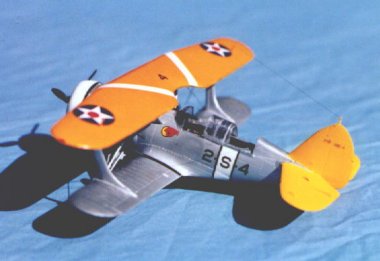
Classic Airframes 1/48 SBC-4 Helldiver
Price: $29.95 (varies by source - search for bargains)
Media: Limited-run injection-molded plastic with photo-etch brass and resin detail parts.
Decals: VMO-151 in 1942; French Aeronavale, 1940.
Accuracy: Scales out with the article in Air Enthusiast No. 5.
Overall: A-/B+
Reviewed by: Thomas McKelvey Cleaver (THE AERONUT)

In a tribute to the power of advertising, the Curtiss SBC-3 and SBC-4 Helldivers somehow came to epitomize Naval carrier-based aviation of the 1930s. In reality, they were not very good dive bombers: they were short-ranged and carried a limited war load, a tradition their successor the SB2C would carry forward into the Second World War. The SBC-4, powered by an P&W R-985 (the SBC-3 was powered by a Wright Whirlwind), carries the distinction of being the last combat biplane ordered by the U.S. Navy, 110 being ordered and built in 1939. It served with only one front-line squadron, VS-2 aboard "Lexington," but saw widespread usage with Naval Reserve squadrons, as well as two US Marine scouting squadrons. Fifty of them were given to France in May 1940, but by then it was too late for them to be chewed up in the German attack and they spent the war rotting away on Martinique until they were burned by Gaullists in 1943. Replaced aboard "Lexington" by the SBD in early 1941, Marine squadron VMO-151 soldiered on with this thoroughly-obsolete airplane throughout 1942, conducting fruitless antisubmarine patrols from Samoa.
All that said, the Helldiver is a good-looking Navy biplane that does somehow epitomize the Golden Age, and I was very excited to see it numbered among Classic Airframes' future releases earlier this year. (I am really looking forward to the P-12E/F4B-4) So when it showed up in my local hobby shop, it was a no-brainer that I would pick it up and get to work.
To understand what one gets in this kit, it's necessary to digress a bit and deal with the history of kit manufacturing in the former Czechoslovakia. When the Cold War was still on and access to Western products was limited, a small company named MPM made some of the best vacuforms one could find anywhere, with surface detail that rivaled anything in an injection-molded kit, and they made models no one else was likely to touch. In the 1990s, the company split in two, one remaining as MPM, and one becoming Eduard. Since then, Eduard has become the more advanced company in terms of production quality with their World War I models. LTD (Squadron) hooked up with MPM to make limited-run kits (the PZL P-11, Dewoitine D-520, Yak-9, Boomerang), while Eduard went with Classic Airframes.
Eduard now has an injection-molding process that makes limited-run kits as delicate as anything the mainstream Japanese companies do. Classic Airframes kits since the I-153 have largely reflected this. Thus, it was a surprise to open the SBC-4 box and see a mix of parts I never thought to see: finely-molded wings and tail surfaces that defined modern Eduard, mated to a thick, fairly clumsy, and distinctly warped fuselage that screamed MPM at its earliest. A possible explanation is that Classic Airframes contracted with both to speed production of what is a very ambitious announced release schedule.
At any rate, no amount of soaking the fuselage halves in hot water would do more than make the warp a bit less bad. I proceeded to construct the very nice cast-resin cockpit, and apply the photo-etch brass fuselage frame and set in the bulkheads for the landing gear well. All of this fit well with only a minimum of pre-fitting and sanding. I then painted and detailed all the inner stuff.
Putting the fuselage halves together was major work: I used super glue, started at the front and worked my way back in 1/2" segments, drying it with zip kicker applied with a pipe cleaner as I went along. This was because the forward section was the most badly warped. I had to keep holding the fuselage in such a way that when I got to the rear, the vertical tail and rudder would mate. I then fitted the lower wing into position and ended up using quite a bit of putty to get a smooth surface.
The cabane struts are not properly sized, and only way to fit them is to attach the outer wing struts in position solidly, attach the upper wing with a tad of superglue to hold it temporarily, then cut and trim the cabane struts to fit. It's not hard to do, but it is time-consuming.
The Pratt & Whitney R-985 is very nice, done in resin with separate cylinders. I had to clean flash off the cowling, but it fit well to the front fuselage.
I decided to do my model as 2-S-4, the Second Section Leader of VS-2, since I had a VS-2 insignia on an old Micro-Scale 1/72 sheet that was overlarge in 1/72 and close enough in 1/48, although a photograph in "Helldivers in Action" shows it to be a very large insignia. I use Gunze-Sanyo H-24 Orange-Yellow for upper wing color on my US Navy Golden Age aircraft, and finished the rest with Model Master non-buffing aluminum and sprayed with Testors Glosscoat. (USN airplanes of this period were painted silver, not left natural metal). The rigging of this biplane is very simple and was done with my usual painted-silver .008" brass wire.
The SBC-4 looks good in my collection, and I look forward to doing the Enterprise CAG's SBC-3 when that kit comes out, but if it's anything like this one, I can only recommend these Helldivers to modellers who are quite experienced with limited-run kits, who are highly motivated to have a 1930s Helldiver in their collection.
Copyright ModelingMadness.com. All rights reserved. No reproduction in any form without express permission from the editor.
Back to Reviews Page 2025